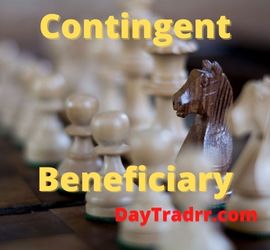What Is a Contingent Beneficiary?
 What is a contingent beneficiary? It is the person next in line to receive a beneficiary-named account if the primary beneficiary is unable or unwilling. A contingent beneficiary is a secondary beneficiary who is essentially waiting in the wings, just in case. In other words, a contingent beneficiary is a person who receives an inheritance next in line after the primary beneficiary. For example, if the primary beneficiary dies, this person will inherit the named assets. If the account you designate to be given to a primary beneficiary cannot be found, declines the gift, is not legally able to accept it, or dies before you do, the account will be released to your second choice as the beneficiary.
What is a contingent beneficiary? It is the person next in line to receive a beneficiary-named account if the primary beneficiary is unable or unwilling. A contingent beneficiary is a secondary beneficiary who is essentially waiting in the wings, just in case. In other words, a contingent beneficiary is a person who receives an inheritance next in line after the primary beneficiary. For example, if the primary beneficiary dies, this person will inherit the named assets. If the account you designate to be given to a primary beneficiary cannot be found, declines the gift, is not legally able to accept it, or dies before you do, the account will be released to your second choice as the beneficiary.
A contingent beneficiary is a person or entity designated by an insurance contract holder or retirement account owner. They are next in line to receive proceeds if the primary beneficiary is deceased, unable to be found, or refuses the inheritance at the time the proceeds are to be paid. A contingent beneficiary is only entitled to insurance proceeds or retirement assets if certain predetermined conditions, such as information found in a will, are met at the time of the insured’s death.
What is a Contingent Beneficiary Example?
Almost any conditions can be imposed on a contingent beneficiary of a will. It is entirely up to the person who draughts the will. If the primary beneficiary accepts an inheritance, the contingent beneficiary receives nothing. Assume William names his spouse, Susan as the primary beneficiary of his life insurance policy and their two children as contingent beneficiaries. When William passes away, Susan receives the insurance payout while the children receive nothing. However, if Susan dies before William, their children each receive half of the estate as contingent beneficiaries.
After major life events such as marriage, divorce, birth, or death, contingent beneficiaries must be reviewed and updated. For example, after William and Susan divorce, William changes the beneficiary designation on his life insurance policy. He decides that the two children should become the primary beneficiaries with no contingent beneficiary for the time being. In this way, William successfully prevents Susan from receiving the proceeds of his life insurance policy.
Contingent Beneficiary Characteristics
People, organizations, estates, charities, or trusts can all be contingent beneficiaries. Minor children and pets are not eligible because they lack the legal capacity to accept assigned assets. If a minor is named as a contingent beneficiary, a legal guardian is appointed to manage the funds. This arrangement stays in effect until the minor reaches the age of majority. Immediate family members are more common as contingent beneficiaries. However, close friends and other relatives are frequently included as well.
A life insurance policy or retirement account may have multiple contingent beneficiaries. Each beneficiary receives a specific percentage of the funds, totaling 100 percent. A contingent beneficiary receives assets in the same way that the primary beneficiary does. For example, if a primary beneficiary were to receive $2,000 per month for ten years, a contingent beneficiary will receive the same amount.
Contingent Beneficiary Advantages
Naming a contingent beneficiary for a life insurance policy or retirement account saves time and money spent on probate. Probate is the legal process of distributing a deceased person’s assets when there is no will.
Advantages
- Avoids probate – Accounts with these types of designations are often referred to as substitute wills. They can be very useful if you want to avoid probate of at least some of your assets.
- Can be updated – Beneficiaries can be changed as your life circumstances change. Your choice of beneficiaries, as well as any changes you make to them, will take precedence over any and all terms you leave in your will for the same assets. You should go over your designations every now and then to make sure they still apply to your current stage of life. The need to update your estate plan frequently arises as a result of major life events. For example, marriage, birth, divorce, or death in the family.
Disadvantages
- Cost to settle – The greater the size of your probate estate, the more expensive it is to settle. This reduces the value of what you can leave to your probate heirs. Naming beneficiaries to remove the accounts out of your estate can be beneficial.
- Update beneficiaries – If you fail to keep your beneficiaries up to date, your plans can quickly unravel. Also, your beneficiaries should be aware that they are either first or second in line. Moreover, they should be aware of the specifics of what they have been designated to receive. When the time comes, it’s often up to them to file claims for the assets in question.
Frequently Asked Questions
What is a contingent beneficiary vs a secondary beneficiary?
The primary beneficiary is the person who receives your death benefit first. If the primary beneficiary dies before you, the next in line is a secondary or contingent beneficiary. Some people also name a final beneficiary in case the primary and secondary beneficiaries pass away before them. For example, a final beneficiary can be a charity, foundation or trust, or educational institution.
What is a contingent beneficiary for an IRA?
A retirement account owner can set up contingencies that prevent an inheritance if certain conditions are not met. For example, an IRA owner could name their child as the contingent beneficiary. However, it could include a provision that the child can only inherit the money after finishing college. Following the passage of the SECURE Act in 2019, non-spousal beneficiaries must withdraw 100 percent of the IRA funds by the end of the tenth year following the death of the IRA owner.
Why is choosing a beneficiary important?
Certain accounts, such as life insurance policies, pension plans, and retirement accounts, require you to name a beneficiary. When you die, the proceeds from these accounts typically go directly to your beneficiaries. This avoids the lengthy and costly legal process of distributing your assets after your death through probate. Needless to say, this saves your family and beneficiaries time and money.
Up Next: What Is Pegging?
 What is pegging? In economics, pegging is the act of linking the value of an asset or currency to the value of another asset or currency establishing a fixed exchange rate. In general, the term refers to the practice of attaching or tying a country’s currency exchange rate to another country’s currency. Fixed-rate pegging involves using preset ratios. The practice is often used by central banks to provide stability to a nation’s currency by linking it to a more stable currency.
What is pegging? In economics, pegging is the act of linking the value of an asset or currency to the value of another asset or currency establishing a fixed exchange rate. In general, the term refers to the practice of attaching or tying a country’s currency exchange rate to another country’s currency. Fixed-rate pegging involves using preset ratios. The practice is often used by central banks to provide stability to a nation’s currency by linking it to a more stable currency.
The United States dollar is regarded as the world’s reserve currency. As a result, several countries utilize the dollar as a currency peg. However, pegging has applications beyond linking currencies. For example, the concept is applied to options trading and cryptocurrencies. The objective is to establish a fixed exchange rate for a stable, secure asset. In turn, this reduces volatility and offers stability to the linking asset. Commodities with reasonably constant pricing can help to stabilize an asset that is suffering too much volatility.




